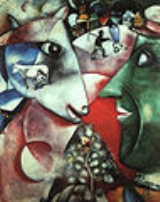
I and the Village
Encyclopedia

Marc Chagall
Marc Chagall Art critic Robert Hughes referred to Chagall as "the quintessential Jewish artist of the twentieth century."According to art historian Michael J...
. It is currently exhibited at the Museum of Modern Art
Museum of Modern Art
The Museum of Modern Art is an art museum in Midtown Manhattan in New York City, on 53rd Street, between Fifth and Sixth Avenues. It has been important in developing and collecting modernist art, and is often identified as the most influential museum of modern art in the world...
, New York.
The work contains many soft, dreamlike images overlapping each other in a
continuous space: in the foreground, a cap-wearing green-faced man stares at a goat or sheep with the image of a smaller goat being milked on its cheek. In the foreground is a glowing tree held in the man's dark hand. The background features a collection of houses next to an Orthodox
Eastern Christianity
Eastern Christianity comprises the Christian traditions and churches that developed in the Balkans, Eastern Europe, Asia Minor, the Middle East, Northeastern Africa, India and parts of the Far East over several centuries of religious antiquity. The term is generally used in Western Christianity to...
church, and an upside-down female violinist in front of a black-clothed man holding a scythe
Scythe
A scythe is an agricultural hand tool for mowing grass, or reaping crops. It was largely replaced by horse-drawn and then tractor machinery, but is still used in some areas of Europe and Asia. The Grim Reaper is often depicted carrying or wielding a scythe...
. Note that the green-faced man wears a necklace with St. Andrew's cross, indicating that the man is a Christian. As the title suggests, I and the Village is influenced by memories of the artist's place of birth and his relationship to it.
The significance of the painting lies in its seamless integration of various elements of Eastern European folktales and culture, both Russian and Yiddish. Its clearly defined semiotic elements (e.g. The Tree of Life) and daringly whimsical style were at the time considered groundbreaking. Its frenetic, fanciful style is credited to Chagall's childhood memories becoming, in the words of scholar H.W. Janson, a "cubist fairy tale" reshaped by his imagination, without regard to natural color, size or even the laws of gravity.
Sources
- Charlotte Douglas, Jeannene M. Przyblyski, I and the village: early works, Jewish Community Museum, 1987
- Rosenblum, Robert. Cubism and Twentieth-Century Art. New York: Harry N. Abrams, 1966.

